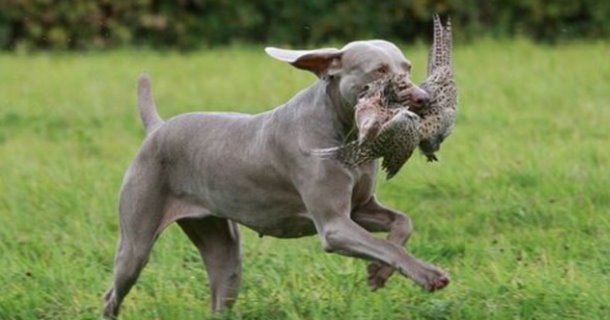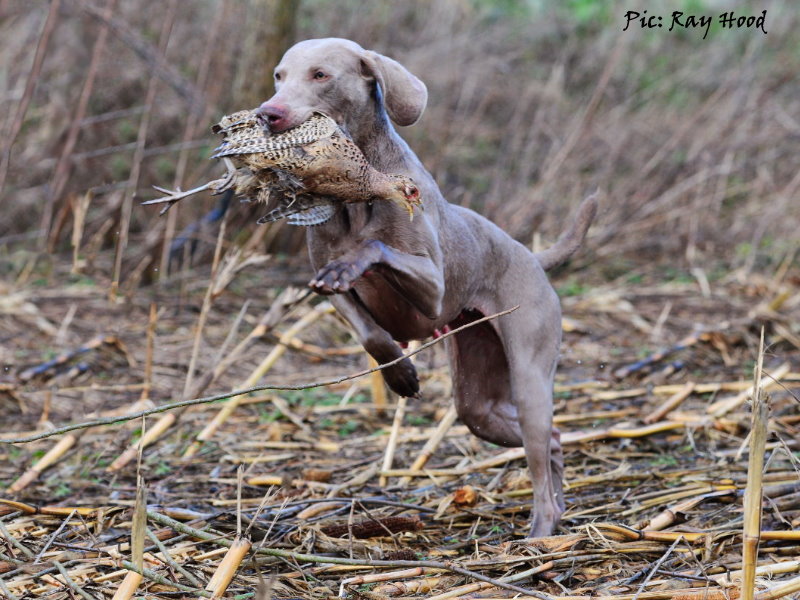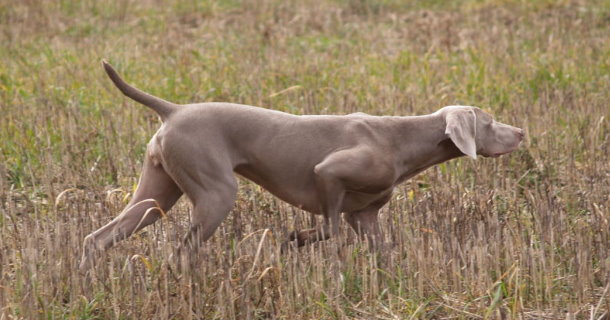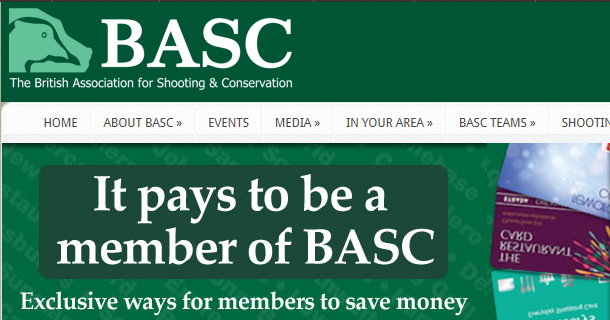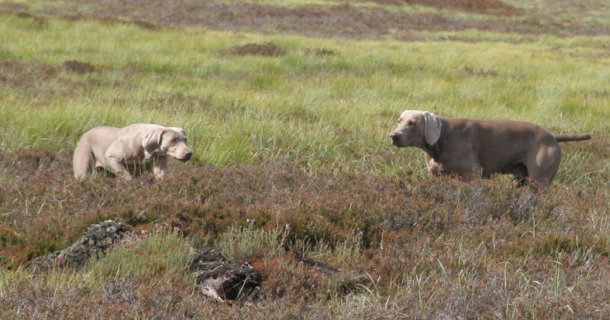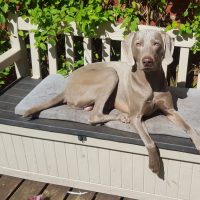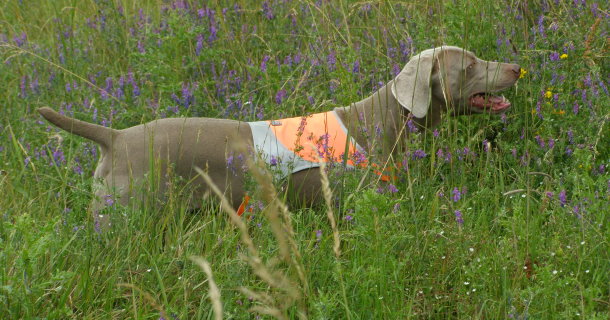
Working Tests – A Personal Introduction
or
How it all started
When I started out I had been involved with weimaraners for over 10 years, and, as many dog owners would do, followed the “obedience” route when undertaking structured training for my first weimaraner, Storm. It wasn’t until I decided to add Misty, a show pup, to my family of pet weimaraners which by then included Max, a rescue, and actively campaign her round the various Open and Championship shows did I begin to meet with fellow owners who would say to me, “Of course you should work her, that’s what they were designed for”.
I realised that “working” per se meant having a superbly trained animal to hunt, point and retrieve on the grouse moors or on lowland pheasant shoots. Living in darkest, deepest Hampshire I knew I would be well-served by good local ground to train on for such activities, but the very idea that I could train my wee pup to do all those good things in a structured and disciplined way seemed too daunting, and after all, I didn’t have the time. And even if I did, where to start and with whom?
I talked it over with a few show friends and discovered that there was a whole new sporting activity out there which would equip me with the skills and techniques to develop my little show pony into that superbly trained HPR I had always wanted. This newly discovered sporting activity is the world of Gundog Working Tests, which aim to simulate on testing ground and in water, many of the activities that a working HPR would experience on a proper shoot, and you didn’t need to shoot or even own a gun, but you did need a gundog, and by now I had plenty!
But just how difficult would it be to enter and be accepted into this new, almost, to my perception, closely knit underground activity, with a weimaraner, and being complete novices, dog and man both. If I was going to introduce Misty and myself into this company it was important to me not to bring weimaraners and their owners into disrepute and be regarded as badly trained and ill-disciplined and worse, have Misty labelled “Typical Bloody Weimaraner”.
We needed an introduction, in the company of friends and fellow travellers and this came about when I succumbed to the encouragement of my weimy friends and went on a WCGB Working Test Day at Tenterden in Kent at the back end of April. I organised to go, knowing some fellow beginners would be going also and we would be able to support each other, there is safety in numbers!
Now then, I had always encouraged my other weimaraners to be active retrievers, swimmers and all-round terrain rangers, and to hunt for fun, and Misty was having fun following their lead, especially in water, This was just fun and not working at all!. I just needed to appreciate how best to train Misty to do whatever was required in a working test, to order, and in a way which would pass muster in competition with other HPR’s.
This is where the weimaraners-only Club working test day at Tenterden came into its own. This was at the invitation of the late Beate Dwingelo- Lutten, of the Haselunne Weimaraners Kennel. We “special beginners” were marshalled together for a whole morning to receive instruction from a very experienced HPR trainer, Alan Parr. I will say right now that it helped greatly that I had taught Misty some basic obedience, sit, sit-stay, recall, heel and the like, although Alan worked wonders with the younger pups who were part of our 10 or so group. Alan emphasised the importance of consistent communication, both spoken and also in body language.
As the morning progressed we began to discover which elements would form a typical working test, basically retrieving and hunting to a pattern.
After a few elementary manoeuvres to establish the principle that not every thrown dummy (a 1lb sealed canvas bag the size of a baked bean tin), is intended for the dog to retrieve, and to induce “steadiness” when a dummy is thrown, and a reminder that the dog should be capable of a sit-stay we were ready for some specific training. Some had brought whistles but at this level they were not extensively used, and in the fullness of time it would be used minimally.
The Memory Retrieve:
We covered memory retrieves where you walk the dog to heel 20 yards or so to a marker, sit the dog, walk on alone for another 20 yards, chuck the dummy ahead of you, and return to the judge while the dog remains at the 20 yard marker. To get your dog to “mark” the dummy’s fall, it helps to slap it, the dummy that is, on your palm to get the dog’s attention. The judge will tell you when to send your dog with the “back” command. The dog should find and collect the dummy and return it to your hand without doing a detour around the field.
Of course, with 10 dogs doing a memory retrieve in quick succession we had every possible permutation of delivery, non-delivery, detour, puzzlement and out and out mischievousness.
Believe me it was an hilarious experience, and all the laughing was done with and not at our fellow instructees.
The Seen Retrieve:
This time the dog and handler would stay with the judge while a dummy is thrown by the dummy-thrower, usually, at working tests, a man with chiselled features and whiskers and/or grizzly sideburns, wearing a flat cap, and with his waterproof trousers secured with a piece of string. The dummy-thrower would slap the dummy to his palm and warble like a turtle-dove which would induce a cocked head in your puzzled weimaraner. But when the dummy flies through the air the dog will immediately focus on the fall and mark the landing spot.
Naturally during this exercise the various dogs’ performances were, well, varied.
The Water Retrieve:
This is a retrieve of the dummy from water and although we did not cover this during the WCGB Special Beginners morning, it is usually a feature of all classes at a WT day, with varying degrees of complexity built in, depending on the class, Puppy, Novice, Open etc.
The Hunt:
Alan taught some basic techniques for getting your dog to hunt in a formal pattern (“quartering the ground”), and what was remarkable was that virtually all the dogs picked up very quickly what was required of them. There was no game or dummies to find at this level, but the dog should show an aptitude for hunting, that is ranging efficiently over the ground, scenting en route. The dog should be under control.
Heelwork, Sit, Sit-Stay, Recall were rehearsed and tested as distinct activities during the morning training session, but they also formed part of the rubric for the retrieves and the hunting.
In the afternoon Alan judged the formal Working Test and at the end of the day we gathered together with all the other handlers who had done Puppy, Novice and Open classes and to my great delight we were awarded 1st Place in our class.
It’s not the winning but the taking part, well, being placed (top five) is usually a great confidence booster and incentive to get out there at other working test events. This was certainly true for me and after seeking and receiving advice from a friendly working test guru, known as Claire, as to which level of test to enter, we were raring to have another go, this time at a multi-breed WT Day organised by the Brittany Club of Great Britain, down on the Hamptworth Estate near Salisbury, in May.
Our first multi-breed WT Day with the Brittany Club is a whole new story GWT BCGB, suffice to say, after a tricky start in the Hunt, we did ourselves and the breed proud with a place in the top five, behind a bevy of GSP’s but ahead of several other breeds. We accomplished this by practising in the lead up to the WT Day, just the basic training given to us by Alan Parr just a few weeks previously.
I will say it is a rather daunting prospect, before the event, pitting yourself and your dog against others in serious competition, and when I arrived at the Estate and saw the competition I did feel a bit like the guys in the film “Deliverance”. If I heard duelling banjos wafting through the undergrowth, I tried to tell myself it was just my imagination!
As it happened, many I met where people I was on nodding terms with from showing, but even those who weren’t were just as friendly. A word of advice though. There is an etiquette to follow while others are doing their test, and a no bright clothing rule. Don’t take your IPod, but do take some snacks, something to drink, and wellies. By the way don’t forget you will need two dummies. Unless your name is Quest, then it would be a good idea to write your name on them if you want them back.
Working Test Days are held from spring to late summer by the various Gundog Breed Clubs and other regional Gundog Societies. They only cost a few pounds to enter. They are great fun, involve a whole day in the country with like-minded people and you and your dog will have a great time.
Finally Esther, as the tests get progressively more challenging, with more complex retrieves, blind retrieves, splits, half-blind, etc. requiring more stamina from the dog and direction from the handler, it would be a good idea to start early, with a the Puppy class (up to 18 months in WT), the best class to start with if your dog is young enough, so don’t just sit there, get out there. You can get some training from special trainers, breed club training days or other HPR breed clubs, groups or enthusiasts.
Nigel Wroe
20/04/2008

